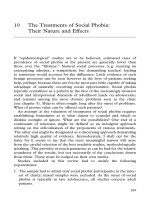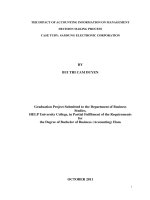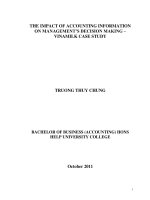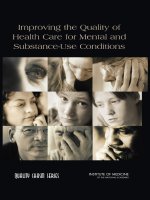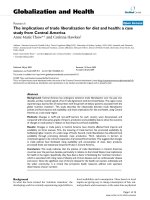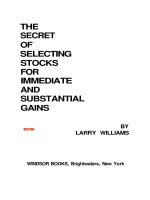The Relevance Of Accounting Information For Valuation And Risk
Bạn đang xem bản rút gọn của tài liệu. Xem và tải ngay bản đầy đủ của tài liệu tại đây (1.02 MB, 317 trang )
The Relevance of Accounting Information for
Valuation and Risk
Submitted in Fulfilment of the Requirements of the Degree of Doctor of
Philosophy, Griffith University
February, 2003
PhD Thesis, Mr. Mark Andrew Brimble, School of Accounting, Banking
and Finance, Griffith University, Brisbane, Australia
Submission Statement
In compliance with the requirements relating to admission to examination and
submission of theses, for the Degree of Doctor of Philosophy of Griffith University, I
hereby certify that this work has not previously been submitted for a degree or
diploma in any university.
To the best of my knowledge and belief, the thesis
contains no material previously published or written by another person except where
due reference is made in the thesis itself.
Mark Andrew Brimble
II
Acknowledgments
Firstly, my most sincere thanks to my thesis supervisor, Professor Allan Hodgson, for
his unwavering support and guidance. Your passion for research is inspiring and your
willingness to make time for me in your hectic schedule is greatly appreciated.
I also wish to thank the members of the School of Accounting, Banking and Finance
for their support and friendship over the past three years. Particular thanks to Peta for
your support and sympathetic ear.
Also to Dr Eduardo Roca (my associate
supervisor) for your support, advice and detailed comments on my work, particularly
in the later stages.
Further thanks goes to Professor Marc De Ceuster for his
comments and input, seminar participants at Griffith University, The Australian
National University, The Queensland University of Technology, the 2001 AAANZ
Conference, the 2001 AAAA Conference, the 24th Congress of the European
Accounting Association, and the 2002 Australasian Banking and Finance Conference.
Special thanks is reserved for my parents. Thank you both for your love, support and
guidance over the years. Without you I would not have gotten to where I am today.
Finally, to my darling wife Tanya. You are my light and inspiration, always there
when I need you with a smile and a hug. Your ceaseless love and support have made
this possible, enjoyable and worthwhile.
III
Abstract
A key theme in capital markets research examines the relationships between
accounting information and firm value. Two concerns relating to the value relevance
of accounting information are: (1) concerns over the explanatory and predictive power
of the evidence presented in the prior literature (Lev, 1989); and (2) the evidence of a
deterioration in the association between accounting information and stock prices over
the past four decades (Collins, Maydew and Weiss, 1997; Francis and Schipper, 1999;
Lev and Zarowin, 1999). These concerns provide the key motivation for this thesis
which examines: (1) the usefulness of the clean surplus accounting equation in
valuation; (2) the role of accounting information in estimating and predicting
systematic risk and; (3) the changing nature of the relationship between accounting
information, stock prices and risk over time.
The empirical research provides evidence of the value-irrelevance of the clean surplus
equation and that controlling for the functional form of the earnings-returns
relationship is more important. Evidence is also provided that accounting variables
are highly associated with M-GARCH risk betas and also possess predictive ability
relative to these risk measures. Finally, the relationships between stock prices, risk
models and accounting information are shown to have not deteriorated over time,
contrary to prior evidence.
Rather, the functional form of the relationship has
changed from linear to a non-linear arctan association.
Overall, accounting
information continues to play the central role in the determination of stock prices and
risk metrics.
IV
Contents
Chapter 1: Introduction
1
1.1 Introduction
1
1.2 Objectives of the Thesis
2
1.3 Importance of the Research
7
1.4 Outline of the Thesis
9
Chapter 2: Literature Review: The Value Relevance of
Accounting Variables
11
2.0 Introduction
11
2.1 Capital Markets Research in Accounting
13
2.1.1
The Early Research
13
2.1.2
Development of the Literature
17
2.1.3
Overall Usefulness of the Value Relevance Literature
17
2.2 The Value Relevance of Accounting Information
21
2.3 The Earnings Response Coefficient
22
2.3.1
Determinants of the ERC
23
2.3.2
The Early ERC Literature
24
2.3.3
Low Explanatory Power
25
2.4 Other Earnings Studies
2.4.1
The Value Relevance of the Components
28
30
of Earnings
2.4.2
The Firm Size Effect
34
2.4.3
The Stability of the Earnings-Returns Relation
36
V
2.5 The Value Relevance of Non-Earnings Data
37
2.6 The Clean Surplus Relation and Stock Valuation
41
2.6.1
Defining the Clean Surplus Relation
42
2.6.2
The Early Research
42
2.6.3
Recent Research
45
2.7 The Long-Term Changes in the Value Relevance of
51
Accounting Information
2.7.1
Reasons Proposed for the Declining Relevance
52
of Financial Statements
2.7.2
Initial Evidence
55
2.7.3
Recent Developments/Extensions
61
2.8 Summary
63
Chapter 3: Literature Review: The Risk Relevance of Accounting
Variables
65
3.0 Introduction
65
3.1 The Relevance of Risk Research
65
3.2 Accounting Standards Related to Risk
67
3.3 Systematic Risk
71
3.4 The Risk Relevance of Accounting Information
77
3.4.1
Early Research
77
3.4.2
Research Extensions
81
3.4.3
The Australian Evidence
85
3.5 Summary
86
VI
Chapter 4: Research Design Issues in Capital Markets Research
88
4.0 Introduction
88
4.1 Research Design Issues in Capital Markets Research
88
4.1.1
Earnings-Returns Regression Specifications
89
4.1.2
Market Efficiency
94
4.1.3
Valuation Models
96
4.1.4
Levels or Differences?
101
4.1.5
Non-Linearity – Earnings Levels and Permanence
102
4.2 Research Design Issues in Beta Risk Estimation
108
4.2.1
Length of the Time Interval
109
4.2.2
Length of the Return Holding Period
110
4.2.3
Adjustments for Thin Trading
110
4.2.4
Adjustments for Central Tendency
112
4.2.5
Portfolio Formation to Reduce Estimation Errors
115
4.2.6
Adjustments for Leverage
115
4.2.7
Time Variance of Beta
119
4.3 Summary
122
Chapter 5: Dirty Surplus Accounting, Functional Relationships, and
the Valuation Role of Accounting
123
5.0 Introduction
123
5.1 Background Literature
127
5.2 Dirty Surplus Variables in Australia
131
5.2.1
Asset Revaluations
131
5.2.2
Foreign Currency Translations
132
VII
5.2.3
Prior Period Adjustments
133
5.2.4
Extraordinary Items
134
5.3 Data and Method
136
5.3.1
Database
136
5.3.2
Linear Models
142
5.3.3
Size and Leverage
144
5.3.4
Knowledge of the Operating Earnings Stream
146
5.3.5
The Impact of the Length of the Returns
148
Estimation Window
5.3.6
Loss Versus Profit Making Firms
5.4 Empirical Results
150
151
5.4.1 Linear Regression Results
151
5.4.2 Comparison with Previous US and UK Results
153
5.4.3 Non-Linear Regression Results
155
5.4.4 Size and Leverage Effects
159
5.4.5 The Impact of the Length of the Return Window
161
5.4.5 Profit Versus Loss Making Firms
164
5.5 Summary and Conclusions
Chapter 6: The Association Between Accounting Risk Variables
166
170
and Risk
6.0 Introduction
170
6.1 Background Literature
173
6.2 Data and Variables Used
176
6.2.1 Beta Estimation
178
VIII
6.2.2 Accounting Risk Variables
6.3 Regression Models
179
190
6.3.1 Industry Regressions
192
6.3.2 Statistical Validation of the Regression Models
194
6.4 Results
6.4.1 The Association Between Accounting Risk Variables
195
196
and Beta
6.4.2 Industry Beta Results
6.5 Summary
Chapter 7: The Predictive Ability of Accounting Risk Variables
206
208
211
7.0 Introduction
211
7.1 Prediction Models
212
7.1.1 Regression Models
213
7.1.2 Out of Sample Forecasting Models
214
7.13 Statistical Validation of the Results
217
7.2 Results
218
7.2.1 Regression Results
218
7.2.2 Forecasting Results
221
7.3 Summary
Chapter 8: The Long-Term Value Relevance of Accounting
232
235
Information
8.0 Introduction
235
8.1 Data and Method
239
IX
8.1.1
Initial Regression Models
240
8.1.2
Extensions
246
8.2 Results
250
8.2.1
The Earnings Relation
251
8.2.2
The Balance Sheet Relation
253
8.2.3
The Ohlson Relation
254
8.2.4
Size Effects
256
8.2.5
Leverage Effects
259
8.2.6
The Effect of Transitory Items
261
8.2.7
The Risk Relevance of Accounting Information
266
8.3 Summary
Chapter 9: Summary and Conclusion
270
273
9.0 Overview of the Thesis
273
9.1 The Value Relevance of Dirty Surplus Accounting Flows
274
9.2 The Risk Relevance of Accounting Information
275
9.3 Long Term Trends in the Value Relevance of Accounting
277
Information
9.4 Conclusions
References
279
280
X
List of Figures
Figure 4.1
Hypothetical Non-Linear Relationship of
104
Earnings and Returns
Figure 8.1
Comparison of the Explanatory Power (R2) of the
264
Linear and Non-Linear Earnings Association Models
Figure 8.2
Comparison of the Earnings Response Coefficients
265
(ERC) of the Linear and Non-Linear Earnings
Association Models
Figure 8.3
Comparison of the Explanatory Power (R2) of the Linear
266
and Non-Linear Ohlson Association Models
XI
List of Tables
Table 5.1
Sample Distribution by Industrial Sector
137
Table 5.2
Descriptive Statistics for the Ten Year Pooled Data Set
142
Table 5.3
The Value Relevance of Operating Profit and the Incremental
152
Value Relevance of Dirty Surplus Flows – Linear Regression
Analysis
Table 5.4
The Value Relevance of Operating Profit and the Incremental
156
Value Relevance of Dirty Surplus Flows – Non-Linear
Regression Analysis
Table 5.5
Comparison of the Linear and Non-Linear R-Squared Statistics
158
Table 5.6
The Impact of Firms Size on Operating Profit and the
160
Incremental Value Relevance eof Dirty Surplus Flows –
Linear Regression Analysis
Table 5.7
The Impact of Financial Leverage on Operating Profit and the
162
Incremental Value Relevance eof Dirty Surplus Flows –
Linear Regression Analysis
Table 5.8
The Earnings Returns Association with Differing Return
163
Windows
Table 5.9
The Incremental Value Relevance of Dirty Surplus Flows
165
for Profit and Loss Reporting Firms – Linear Regression
Analysis
Table 6.1
Sample Distribution by Industrial Sector
177
Table 6.2
Descriptive Statistics for the Ten Year Pooled Data Set
190
Table 6.3
Descriptive Statistics for the Industry Sub Samples
193
Table 6.4
The Association between Betas and Accounting Risk
197
Variables: 1991-2000
Table 6.5
The Association between Betas and Accounting Risk
199
Variables: 1991-1995
Table 6.6
The Association between Betas and Accounting Risk
201
Variables: 1996-2000
Table 6.7
Summary Statistics: Accounting Variables as Estimators of
205
Systematic Risk
XII
Table 6.8
The Association Between Betas and Accounting Risk
207
Variables: The Impact of Industry
Table 7.1
The Predictive Ability of Accounting Risk Variables:
220
Regression Tests
Table 7.2
Predictive ability of Accounting Risk Variables: Long
222
Term Forecasting Results
Table 7.3
Predictive ability of Accounting Risk Variables: Short
225
Term Forecasting Results: OLS Beta
Table 7.4
Predictive ability of Accounting Risk Variables: Short
227
Term Forecasting Results: Thin Trading Adjusted Beta
Table 7.5
Predictive ability of Accounting Risk Variables: Short
228
Term Forecasting Results: Central Tendency Adjusted Beta
Table 7.6
Predictive ability of Accounting Risk Variables: Short
230
Term Forecasting Results: Unlevered Beta
Table 7.7
Predictive ability of Accounting Risk Variables: Short
231
Term Forecasting Results: GARCH Beta
Table 8.1
Industry Membership of Sample Firms
239
Table 8.2
Descriptive Statistics
241
Table 8.3
The Long-Term Association Between Earnings and
252
Stock Prices
Table 8.4
The Long-Term Association Between Stock Prices and
254
Book Values
Table 8.5
The Long-Term Association Between Stock Prices and
255
Earnings Plus Book Values
Table 8.6
The Long-Term Association Between Accounting Information
258
and Stock Prices: The Impact of Firm Size
Table 8.7
The Long-Term Association Between Accounting Information
260
and Stock Prices: The Impact of Financial Leverage
Table 8.8
The Long-Term Non-Linear Association Between Accounting
263
Information and Stock Prices
Table 8.9
The Long-Term Association Between Accounting Risk
267
Variables and Stock Prices
Table 8.10
Long-Term Trends in the Association Between
269
Accounting Risk Variables and Stock Prices
XIII
Chapter One
Introduction
1.1
Introduction
Capital markets research in accounting represents a significant area of research within
the accounting discipline. Since the late 1960’s this area of research has rapidly
developed and now covers a vast area of topics in the broader accounting, finance and
economics literature generally. One of the main groups of literature within capital
markets research is the so-called value relevance literature that seeks to determine the
degree to which a given accounting (or other) variable affects stock market values. A
variable is defined as value relevant if it exhibits the predicted association with a
measure of market equity value (Holthausen and Watts, 2001). Historically, a typical
value relevance study examines the association between accounting earnings and
stock prices.
This area of research originated from the work of Ball and Brown (1968) and Beaver
(1968) who were motivated by the theory that financial statements must have some
worth to shareholders since they had survived for so long and financial resources were
required to produce them. This notion led to the pool of literature that examines the
stock price impact of accounting information.
The intuition underpinning this was that the accounting function provides information
that reflects firm performance and consequently should be reflected in stock prices (as
1
a relevant metric of returns to stockholders). Hence, accounting information should
be relevant to investors. This has, however, proven difficult to empirically model
with the literature being characterised by low levels of explanatory power in both
association and prediction tests (Lev, 1989). In response, the literature has developed
to incorporate sophisticated econometric modelling and a vast array of accounting and
non-accounting variables over a large number of institutional frameworks to further
our understanding of the relationship between accounting information and market
measures of performance and value. Despite this, recent review studies such as those
of Kothari (2001) and Barth, Beaver and Landsman (2001) indicate that there is much
still to learn about how accounting information is disseminated, interpreted and
impacted into equity valuations.
Furthermore, there is potential to extend the
literature through dealing with issues in research design.
1.2
Objectives of the Thesis
This thesis examines three interrelated issues in capital markets research in terms of
the value relevance of accounting information; the value relevance of the clean
surplus relation, the risk relevance of accounting information, and the long-term
changes in the value relevance of accounting information.
The first of these deals with the long running debate over clean surplus accounting, an
accounting construct, where successive articulation between income statements and
balance sheets is maintained by not allowing any items, other than dividends and new
capital issues, to bypass the income statement. A review of the literature reveals a
debate that has been ongoing since the 1930’s with those in favour of clean surplus
2
accounting raising concerns over a potential failure to recognise dirty surplus items
(those that bypass the income statement) in a timely manner (May, 1937; Penman,
1992; Ohlson 1995). In contrast, the opponents suggest that this model hinders the
predictive ability of financial statements as it includes transitory and other items that
are not related to the operations of the entity (Paton, 1934, Littleton, 1940, Black,
1993b; Penman, 1996). This issue has again been raised with the development of
valuation models such as fundamental analysis and the Edwards-Bell-Ohlson model
that assumes clean surplus.
The evidence that directly examines the value relevance of dirty surplus accounting to
date (Amir, Harris and Venuti, 1993; O’Hanlon and Pope, 1999) generally concludes
that these flows are not value relevant in the US and the UK with little evidence in the
Australian context. Furthermore, the impact of non-linearities, firm size and leverage
effects, and sensitivities to the parameters of the research design are yet to be fully
explored. This will determine whether dirty surplus accounting techniques hinder the
usefulness of financial statements, under what conditions (ie more or less so for
small/large or lowly/highly levered firms), and whether improved knowledge of the
quality of the earnings stream (the level of transitory components) affects the
relevance of earnings and/or the dirty surplus flows. This thesis examines these issues
from an Australian context, providing further evidence on the clean surplus construct
in terms of the value relevance of accounting earnings in cross section and over
various time periods.
The evidence presented in chapter 5 of this thesis supports the argument that dirty
surplus flows are transitory in nature with only isolated cases of value relevance in
3
aggregation periods of up to ten years in Australia. Further, controlling for size and
leverage does little to improve this.
The value relevance of operating earnings,
however, is shown to increase with aggregation and when transitory items evident in
the short-term are controlled for. This should allay concerns over the use of dirty
surplus accounting techniques, and furthermore point out that knowledge of the
functional relationship between temporary and permanent components of the earnings
stream is an important issue.
The second area of interest is the risk relevance of accounting information. This is
also an important issue of relevance to valuation models, as the incorporation of risk
factors/adjustments into such models provides more realistic estimates of value. The
ability of accounting variables to play a role in risk estimation has received little
attention in the empirical literature since the mid 1970’s leading to calls for further
investigation and updating of the literature in this area (Ryan, 1997). This is despite
the significant pool of literature that has developed in the returns/earnings area of the
capital markets research.
Furthermore, risk research can potentially significantly
contribute to the literature by assisting in (1) the development of more efficient ex
post risk measures; (2) the determination of the actual risk determinants rather than
just determination of the level of risk; (3) overcoming the problem that conventional
ex post measures cannot be used for non-listed entities, initial public offering firms, or
those that do not have sufficient trading history or even those that are not listed on
stock exchanges; and (4) the development of trading strategies and the construction of
portfolios with the desired level of risk (Ryan, 1997).
4
Given these issues, the second area of empirical research examines both the
association between accounting risk variables and estimates of systematic risk, and
the predictive ability of these variables in terms of systematic risk.
This will
contribute by updating and extending the Australian evidence (there is only one
published Australian paper in this area), examining alternate measures of systematic
risk, and improving our understanding of the risk related information content that
accounting variables possess.
Chapters six and seven of this thesis present evidence suggesting that accounting
variables contain value relevant risk related information in terms of both current
period associations and next period forecasts. Furthermore, there is a strong trend in
the risk relevance of specific accounting variables such as operating leverage and
asset based firm size. The accounting variables also exhibit the strongest association
with a GARCH beta and an unlevered beta, both of which are superior to the
traditional OLS beta measure of systematic risk. Evidence is also presented indicating
that industry membership is a key determinant in the risk relevance of specific
accounting variables.
These results provide support for a further role in risk
measurement and management for accounting information in addition to the
profit/return focused use. The evidence also provides an array of additional research
questions that could be the subject of future research.
The third area of empirical research examines the recent evidence that financial
statements have lost their relevance (Collins, Maydew and Weiss, 1997; Francis and
Schipper, 1999; Lev and Zarowin, 1999). This has proven a controversial issue,
particularly in terms of the research designs employed, and one that has not been
5
examined in either the Australian context, or in terms of the role of accounting risk
variables in the long run relationship with market measures of value.
Potential
consequences of a decline in the value relevance of accounting information are
significant in terms of the relative importance of the profession, the demand for
accounting information relative to competing sources of information, and in the longterm, the self-regulatory nature of the profession.
The evidence thus far indicates that the value-relevance of accounting earnings has
declined in the US over the past four decades (Collins, Maydew and Weiss, 1997;
Francis and Schipper, 1999; Lev and Zarowin, 1999; Brown, Lo and Lys, 1999). The
evidence on balance sheet variables is, however, subject to debate as Collins, Maydew
and Weiss (1997) and Francis and Schipper (1999) found small increases in value
relevance over time, while Lev and Zarowin (1999) and Brown, Lo and Lys (1999)
found the opposite. While the issue here is one of research design, the focus is now
the causal factors behind the evidenced change in value relevance over time. Early
suggestions include the prevalence of high technology stocks for which traditional
accounting information is argued to be less relevant, the build up of non-reported
intangible assets and a greater level of reported one-time items and losses.
Given these points, and the fact that this is a relatively new area of research with little
evidence in the Australian context, this appears to warrant examination. This thesis
examines the long run relationship between accounting information and market value
incorporating the risk relevance of accounting information and other research design
issues such as non-linearities.
6
Chapter eight of this thesis presents evidence suggesting that the long-term linear
association between accounting book values and earnings with stock prices has
declined over time and that this is more prevalent for small firms and low leverage
firms in terms of book values and high leverage firms in terms of earnings. The
statistically significant decline in the value relevance of accounting information
dissipates, however, when transitory components within the accounting information
are controlled for through non-linear regression. In fact, over time the non-linear
model becomes more superior to the linear indicating a build up in transitory
components that result in the non-linear model being able to better capture the
relationship. Furthermore, the risk relevance of accounting information is also shown
to remain stable over time with no statistically significant increase or decrease. This
is seen as evidence in support of the notion that accounting information has not
declined in value relevance over time, rather the functional form of the relationship
has changed.
1.3
Importance of the Research
Two of the key ongoing themes of capital markets research in accounting relate to; (1)
the concerns over the explanatory and predictive power of the evidence presented in
the prior literature on the relationship between accounting information and stock
prices (Lev, 1989); and (2) the evidence of a deterioration in the association between
accounting information and stock prices over the past four decades (Collins, Maydew
and Weiss, 1997; Francis and Schipper, 1999; Lev and Zarowin; 1999).
7
The intuition underpinning capital markets research suggests that the accounting
function provides useful information in relation to firm performance, and hence this
should be reflected in stock prices. Therefore, accounting information should be
relevant to investors in their pricing and allocation decisions. The concern in the first
issue above, however, is that the research evidence illustrates a relatively weak
statistical association between reported accounting earnings, as a summary measure of
performance, and stock prices. Lev (1989) suggests a number of reasons for why this
may be the case, including; (1) stock prices are likely to be influenced by other nonearnings information (the omitted variables problem); (2) the estimation procedures
for unexpected earnings introduce measurement error (the errors in variables
problem); and (3) investors are not likely to react identically to earnings information
and hence there is some level of market inefficiency.
The empirical research conducted in this thesis contributes to the literature in terms of
the omitted variables problem by examining the information impact of dirty surplus
accounting flows and accounting risk variables illustrating that these variables
incrementally improve the association between accounting earnings and stock prices.
Furthermore, the errors in variables problem is countered through non-linear
regression techniques to control for the transitory components within accounting
earnings.
The second ongoing theme in the literature stems from the recent evidence of a
decline in the value relevance of accounting information. This thesis directly
contributes to this literature by assessing the long-term association between
accounting information and stock market measures of value in the Australian context.
8
Furthermore, issues such as firm size, leverage, industry, risk and the impact of
transitory components in earnings are examined to determine their role in the
changing nature of the value relevance of accounting variables.
In summary, the importance of this research is defined in terms of its contribution to
our understanding of the functional relationships between the components of
accounting earnings and improving our knowledge of the quality of the earnings
stream. Furthermore, the incremental information content of additional accounting
variables is examined, and the importance of appropriate modelling of information
content is reaffirmed. Overall, accounting information is an important source of
information available to, and used by, investors. Hence, it is important to understand
how this information is utilised by market participants and the role it plays in
determining market prices. This thesis assists in extending this understanding.
1.4
Outline of the Thesis
The thesis examines three areas of interest with an underlying theme of the value
relevance of accounting information and is structured as follows. The next chapter
(chapter 2) consists of a literature review discussing various relevant issues in capital
markets research. The purpose of this is to provide the basic theoretical and empirical
foundation for the thesis and a detailed review of the value relevance of accounting,
particularly earnings, variables. This chapter also contains a review of the dirty
surplus and long window research.
The third chapter provides a review of risk
literature in accounting. The fourth chapter reviews research design issues in capital
9
markets research and in the estimation of systematic risk.
This provides an
introduction to the models employed in the empirical chapters.
Chapters five, six, seven and eight contain the empirical research undertaken in the
thesis. Chapter five examines the value relevance of dirty surplus accounting using
linear and non-linear regression techniques, with additional testing for the impact firm
of size and leverage on the value relevance of the accounting information.
The sixth chapter examines the risk relevance of accounting information in an
association study context. Five measures of systematic risk are utilised to assess a
variety of accounting risk variables for risk specific information content. Chapter
seven extends this into a prediction study, investigating the ability of the accounting
risk variables to predict systematic risk using out-of-sample forecasting techniques.
The eighth chapter examines the long-term relationship between accounting
information and stock prices using a variety of linear and non-linear regression
techniques. Further, the impact of transitory items, firm size, leverage and systematic
risk are examined relative to the theorised decline in the value relevance of accounting
information.
The ninth chapter concludes the thesis with a summary of the findings and discusses
the general implications of the research in terms of its contributions to our
understanding of the relationship between accounting information and firm value, and
its use in the pricing of stocks.
10
Chapter Two
Literature Review: The Value Relevance of Accounting Variables
2.0
Introduction
The broad area of capital markets research encompasses a number of lines of research
in the accounting and finance literature. It can be broadly defined as the pool of
literature that examines the relationships between financial statement information and
the capital markets. The four primary areas of capital markets research according to
Kothari (2001) are (1) fundamental analysis and valuation; (2) tests of capital market
efficiency; (3) the role of accounting in contracting and the political process; and (4)
disclosure regulation.
This thesis falls into the first stream of capital markets
research, the relationship between accounting information and stock returns in a value
relevance setting.
The intuition underpinning this literature suggests that the
accounting function provides information that reflects the performance of an
organisation and consequently should be reflected in stock prices, this metric being
the relevant market measure of returns to stockholders.
Therefore, accounting
information should be relevant and useful for investors in pricing stocks and in their
asset allocation decisions.
The accounting variable that has received the most attention in this area of the
literature is accounting profits. This is due to its high visibility as the ‘bottom line’
summary measure of performance and is commonly published and sighted in the
media and in financial reports. There are also a number of other accounting variables
that have been examined for statistical association with stock returns including cash
11
flows, funds flows, capital structure, balance sheet items and classes of risk.
However, there is much still to be learnt about how the market interprets and acts
upon accounting information, and how the accounting standards can be improved to
better reflect the needs of financial statement users for valuation purposes.
This research does not assume that this is the only role for accounting information, but
simply that it is one of the major roles it takes. It is argued that one of the key roles of
financial reporting is to provide information relevant to current and potential
investors, creditors and other financial statement users in their assessment of investing
decisions. This, however, does not diminish the role of accounting in other areas of
importance such as taxation, contracting, regulation and litigation (Holthausen and
Watts, 2001). Hence, the value relevance literature, which assesses how well the
information used by equity investors in their investment decisions is reflected by
accounting information, draws no inference regarding these other roles.
This chapter reviews several areas of the literature. It commences with a broad
review of the capital markets literature followed by a discussion of the value
relevance of accounting earnings. The remaining sections discuss the role of the clean
surplus relation in the earnings-return association and the evidence of the long-term
decline in the value relevance of accounting information to stock returns. The chapter
is concluded with a summary of the key issues raised in the chapter.
12
